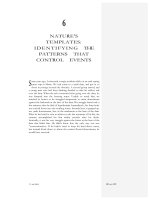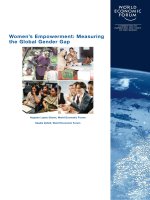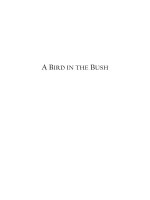Britain's policies towards the EU: Integration or foreign policy theories?
Bạn đang xem bản rút gọn của tài liệu. Xem và tải ngay bản đầy đủ của tài liệu tại đây (365.3 KB, 7 trang )
<span class='text_page_counter'>(1)</span><div class='page_container' data-page=1>
<b>OR FOREIGN POLICY THEORIES?</b>
Chu Thanh Van
*<i>Faculty of English, VNU University of Languages and International Studies, </i>
<i>Pham Van Dong, Cau Giay, Hanoi, Vietnam</i>
Received 27 July 2018
Revised 26 September 2018; Accepted 28 September 2018
<b>Abstract: Together with Brexit has come not only the official spliting of the United Kingdom (UK) </b>
from the European Union (EU) but also the question whether scholars and diplomatic officials should
approach the relationship between the two partners of the UK and the EU from Integration Theory or
Theory of Foreign Policy? This article investigates the effects of both the viewpoints on the practice of
certain diplomatic jobs by the UK’s goverments towards the EU from 1972 to 2016 and the research works
<b>by scholars in the world on this relationship. </b>
<i><b>Keywords: the UK, the EU, Integration Theory, Theory of Foreign Policy, Brexit</b></i>
On the 21st<sub>, June, 2016, the UK’s people </sub>
gathered together in one of the most important
referendums of the history of international
relations to vote for or against the exit from
the EU, in which the country has been a
member since 1972. The referendum results
announced later officially marked the victory
of the Brexit movement, taking Britain out of
the EU, despite all the efforts of the former
Prime Minister David Cameron, creating
shocks to all the international circles of
scholars and diplomatic officials.
<b>1. The process of the UK’s joining and </b>
<b>integrating into the EU 1</b>
After the Second World War, nearly
all the European countries were severely
destroyed and damaged. At first, the European
Coal and Steel Community (ECSC) was set
* Tel.: 84-983606106
Email:
up by the six countries of France, Germany,
Italia, Belgium, Luxembourg and Netherlands
“to unite European countries economically
and politically in order to secure lasting
peace”1
2. In 1957 the European Economic
Community (EEC), or “Common Market”,
was established. Later, the Maastricht Treaty
(1992) combined all the three communities of
ECSC, European Atomic Energy Community
(Euratom), and EEC (or EC since 1993) into
one institution named European Union (EU)
(Tran Thi Vinh, 2011). “The EU did not set out
to become a world power….. But as the Union
expanded and took on more responsibilities,
it had to define its relationships with the rest
of the world.”2
3
With its 28 members, the EU
now has been a world player. “In terms of the
total value of all goods and services produced
1<sub> />
en, retrieved 3:10pm dated 27/7/2018
2<sub> A world player -The European Union’s external </sub>
</div>
<span class='text_page_counter'>(2)</span><div class='page_container' data-page=2>
(GDP), it is bigger than the US economy. EU
GDP in 2017 with €15.3 trillion.”3
1
Being one of the most powerful countries
for many centuries, the UK was surprisingly
rejected the membership into the EEC (later
EC and the EU) in the 1950s and 1960s. In
1961, “Prime Minister Macmillan announced
Britain’s application for EEC membership”
(Pilkington, 2001, p. 14). Worrying that the
French leadership to the EEC would be
affected by the British and that the British,
together with the American, were conspiring
to paralyse the EU from within, the French
President De Gaulle at the time decided to use
his veto to stop the British’s coming into the
EEC. Britain’s second application in 1964 met
the same reactions from De Gaulle. Despite
being rejected the admission into the EEC many
times, Britain was persistently determined
with the application. This policy aimed at two
targets: (1) integrating into and exploiting
the purchase power of this potential market
in order to strengthen the UK’s economy; (2)
sweeping the way for NATO (with the USA
and the UK being two dominants partners
inside) to control this global economic and
political institution, making it ready for their
confronting policies towards the USSR and
its rallies at the time. The UK had to wait
until the French President’s resignation to be
admitted into the Union in 1973 (Pilkington,
2001, p. 14-17).
Until 2016, during 43 years Britain’s
being in the EU, the relationship between
the two partners of the UK and the EU has
undergone numerous ups and downs. Just
after the signing of the Treaty of Accession in
1972 by Edward Heath’s government to fulfill
the requirements for the application into the
EU, the opposite Labour Party won the 1974
3<sub> />
economy_en, retrieved 3:55pm dated 27/7/2018
elections “with a manifesto commitment to
withdraw from the EC” (Pilkington, 2001, p.
18). The results of the referendum supported
Britain’s staying with the EU. However, until
2016, Britain had taken part in many important
institutions of the EU, including The Single
Market, The Court of Justice (of the European
Union), the European Council and the
European Parliament, ect. but had not taken
part in the Schengen (which allows smooth
movements within countries in the group)
and the Eurozone. These are the reasons why
the British are considered to be “an awkward
partner” in the Union (George, 1998) In almost
all the discussions and negotiations at the EU
summit meetings, Britain has been criticized
for refusing a closer cooperation with the
other members to solve the Union’s problems
which relate to economic crisis, monetary
matters and saving or security to immigrants.
In short, before Brexit 2016, Britain in fact
has commited a considerable number of exits
from the EU.
<i><b>2. The Integration Theory and The Theory </b></i>
<i><b>of Foreign Policy</b></i>
In Joshua S.Goldstein’s opinion,
“International integration refers to the process
by which supranational institutions come to
replace national ones – the gradual shifting
upward of sovereignty from the state to
regional or global structures” (Goldstein,
1999, p. 427). Let’s take the integration within
the EU as an example. In order to be accepted
into this institution, the British had to sign the
Treaty of Accession in 19724
2
, which mandated
that the laws by the EU be more superior
and be prioritized in any member country.
In short, part of the country’s sovereignty
in making laws has been transferred to the
EU. The more the country integrates into
</div>
<span class='text_page_counter'>(3)</span><div class='page_container' data-page=3>
the EU, the more of the sovereignty will be
handed to the Union. Also, the more the EU
itself connects its members into the expanded
integration in economy, policies, security,
society and culture, the more centralization
it creates. Therefore, Joshua S.Goldstein later
pointed out: “Integration can mean greater
centralization at a time when individuals,
local groups, and national populations are
demanding more say over their own affairs.
The centralization of political authority,
information, and culture as a result of
integration can threaten both individual
and group freedom. Ethnic groups want to
safeguard their own cultures, languages, and
institutions against the bland homogeneity
that a global or regional melting pot would
create.” (Goldstein, 1999, p. 430)
While the integration theorists look at the
Britain-EU relationship from the view point
considering that Britain is just part of the Union,
and should follow the rules by the EU at any
cost, scholars following The theory of Foreign
Policy claims that the relationship between the
two partners have never been so one-sided; and
that we should consider the relationship under
the light of state interests – one of the most vital
components in foreign policy analysis. The
claims are based on the fact that the decision
of participating in any regional institution of a
country asks for a great deal of calculations and
analysis on its national interest beforehand. To
the calculating British, national interests have
consistently been the utmost important aspects
in any policy to appoach close relationship to
any partner. Henry John Temple Palmerson5
1, one
of the greatest British Prime Ministers in the 19th
century, ever said: “We have no eternal allies,
and we have no perpetual enemies. Our interests
are eternal and perpetual, and those interests it is
5<sub> </sub>
/>prime-ministers/henry-john-temple-3rd-viscount-palmerston
our duty to follow.” In one survey by Chatham
House in 2012, “47 per cent of those surveyed
felt that British foreign policy should support
the national interest at all times, even if it meant
doing things that might be regarded as unethical.”
(Edmunds, Gaskarth, & Porter, 2014, p. 29).
However, here arises a vital question: “What
is a national interest?”. Edmunds, Gaskarth,
& Porter (2014) state that “national interest is
implicitly also one of national identity” (p. 12).
The authors then point out that there are six
ideal roles that the UK might adopt in world
politics to lighten its identity, namely: “isolate,
influential (rule of law state), regional partner,
thought leader, opportunist-interventionist
power and great power” (p. 14). The problem
is if the British really keep in minds the roles
as mentioned above in the integration into the
EU, the conflicts between the two partners are
unavoidable.
<i><b>3. Effects of The Intergration Theory </b></i>
<i><b>and The Theory of Foreign Policy on the </b></i>
<b>relationship between the UK and the EU</b>
</div>
<span class='text_page_counter'>(4)</span><div class='page_container' data-page=4>
Here arises a question: if the two partners
follow different thinking patterns, why did the
British apply for the membership in the EEC
in 1972? The answer is at the beginning of the
foundation, the EU (former EEC or EC) could be
considered a regional organization of economic
cooperation. After the Second World War, “from
being the world’s greatest creditor nation in 1939,
Britain had become the world’s greatest debtor.
Moreover, as a result of the war Britain had lost
most of its overseas markets and was expected
to run a balance of trade deficit of some 2 billion
pounds a year when American Lend-Lease
(effectively a form of aid) came to an end, as it
did abruptly, in August 1945.” (May, 1999, p. 7).
However, the next three decades just witnessed
the British trials in vain to make the economy as
strong as before the War (McDowall, 2002). On
the contrary, the next-door countries in the EEC
had obtained great success in economy, creating
purchasing potentials for goods, services and
labours. The decision to ask for membership in
this community seemed to have been irreversible,
though it was based on merely economic
purposes.
One of the first firing conflicts between the
two partners used to be the amount of money the
EU asked for Britain’s membership. In order to
receive the agreement, the UK had to pay 20%
of the total EU’s annual budget while the 8 other
countries in the community paid the 80% left.
Immediately after Margeret Thatcher came to the
power as the Britain’s Prime Minister in 1979,
the question of British contribution to the EU’s
budget “arose at Mrs Thatcher’s first European
Council meeting and dominated discussions in
the Council for five years…” (Pilkington, 2001,
p. 19). In 1984, the matter was somehow arranged
on the basis that Britain would receive 66% of
the difference between what they gave and what
they got back from the EU funding system, but
“the insistent demands made by Mrs Thatcher
and her domineering and insulting treatment
of her supposed partners had at times almost
turned Britain into a pariah in European circles.”
(Pilkington, 2001, p. 22).
The next Conservative Prime Minister, John
Major, tried to console his peers in the EU at the
beginning of his time in the office by persuading
the British to ratify the Treaty of Maastricht
which turned the EC into the EU in 1992.
However, Britain’s exit from the European Rate
Mechanism (ERM) on the 16 September 1992
and the Britain beef ban crisis since 1989 which
remained unsolvable pushed John Major to fury.
His reactions with the continual use of veto and
arguments with peers at EU meetings once again
lowered the Britain’s ranking in the diplomatic
circles (Pilkington, 2001, p. 92-94, p. 136-137).
Also, he refused to sign the Social Charter, which
is one of the three most important documents of
the Treaty of Maastricht.
During 1997-2010, the leaders of Labour
Party, Tony Blair and Gordon Brown, came into
office. Britain’s economy soon gained surprising
growth rates and the harmony between the two
partners was maintained during Tony Blair’s first
presidency. However, his decision to support
the USA in the bombing of Iraq in 2001 created
fusion among the other EU members, especially
Germany and France (Blair, 2013). To Gordon
Brown, he was criticized because he did not
try to take Britain back into the ERM and the
Eurozone, despite the fact that the country’s
economy had been running better and at the time
was abundantly eligible to access into both. (Do
Ta Khanh, 2013)
</div>
<span class='text_page_counter'>(5)</span><div class='page_container' data-page=5>
economic austerity would not allow him to be
more generous towards the other EU members
who were suffering badly and were waiting for
the support from the UK. David Cameron was
also criticized severely for refusing to share the
burdens by the immigrants with the others (Chu
Thanh Van, 2018). However, it is necessary to
emphasize that the job of being British Prime
Minister is extremely demanding. On the one
hand, the country asks him to protect its citizens’
rights first. On the other hand, peers with the
integration disciplines in mind force him to
distribute the British wealth to all EU citizens,
together with the immigrants coming to the
continent from poverty of Asia and Africa.
Keeping the balance between the two has never
been an easy experience to any leader of the UK.
Brexit really took place on the 23rd<sub> June, 2016, </sub>
which put an end to the awkward positions to
both the UK in the EU and David Cameron.
In short, starting with different thinking
patterns and disciplines, the actions by both sooner
or later would go into different ways, which is
illustrated vividly by the example of Britain - EU
relationship as described above. “It was perhaps
inevitable that the British should see themselves
not only as unique amongst Europeans, but also
as separate and different; and that British policy
towards the continent should be characterized by
‘splendid isolation’” (May, 1999).
<i><b>4. Effects of The Intergration Theory and The </b></i>
<i><b>Theory of Foreign Policy on the approach </b></i>
<b>to research on Britain - EU relationship by </b>
<b>scholars </b>
Different perspectives and approaches
to Britian - EU relationship not only affect
practical jobs by diplomats and politicians
but also direct scholars to different routes and
theoritical frames of their research works.
Conventionally scholars who look at the
Britain - EU relationship from the Integration
Theory would normally try to measure Britain’s
integration into the Union in different areas
(security, economy, social culture, etc.). Or else,
they may analyse the contributions by Britain
to the EU’s three main “pillars” of integration,
as assigned in the Treaty of Maastricht6
1
.
Among them, the first pillar – The European
Communities – handled economic, social and
environmental policies within member countries;
the second pillar of The Common Foreign and
Security policy (CFSP) concerned about foreign
policies (usually to the countries outside the
Union) and military matters in the region or
in the world; and the third pillar named Police
and Judicial Co-operation in Criminal Matters
(PJCCM) saw to cooperation in the fight against
crime both in and outside to protect people and
institutions within the EU. Numerous works by
foreign and domestic scholars have proved to
<i>follow this discipline, such as Europeanization </i>
<i>and Multilevel Governance - Cohesion Policy </i>
<i>in the European Union and Britain by Bache </i>
<i>(2008), International Politics on the World Stage </i>
<i>by Rourke (2008), The Reluctant European by </i>
<i>the Economist (2015), In Defence of Europe: </i>
<i>Defence Integration as a Response to Europe’s </i>
<i>Strategic Moment by The European Commission </i>
<i>(2015), and Adjustments in development policies </i>
<i>of dominant countries in Europe in the periods of </i>
<i>economic crisis and global recession by Nguyen </i>
An Ha (2013)7
2
. In conclusion, there are still a
great number of scholars who consider the EU
a supranational institution, with Britain being a
“unit” inside and the relationship being analysed
from the top-down discipline. In this view, Britain
can not hold its independent position of a country
with full sovereignty to make and implement its
6<sub> Treaty of Maastricht (1992). />
european-union/sites/europaeu/files/docs/body/
treaty_on_european_union_en.pdf
</div>
<span class='text_page_counter'>(6)</span><div class='page_container' data-page=6>
own policies any more. Not only the EU scholars
but also the EU officials and politicians keep this
kind of viewpoint to the Britain’s position in the
EU. But practice has proved that Britain has not
been an easy follower.
On the contrary, scholars approaching the
Britain - EU relationship with Theory of Foreign
Policy in mind regularly focus on the benefits and
costs of the relationship. They tend to look into
a single policy by the British in the cooperation
with other members in the EU. They care enough
to bear in their minds that Britain and the EU are
two independent partners. The research works
of this discipline have a tendency of moving
from theories of power, national interest,
subjects of international relations as individual
states, etc. to the cooperation between various
actors in the world arena. The authors of these
works are also in favour of Realism Theories in
international relations. A great numbers of books,
government reports and research works have
been published under the light of this discipline.
The most noticeable and influential ones include
<i>Introduction: Interpreting British Foreign </i>
<i>Policy by Bevir, Daddow, & Hall (2012), What’s </i>
<i>in a phrase? - The United Kingdom and Ever </i>
<i>Closer Union by Brown (2015), New Labour </i>
<i>and the European Union - Blair and Brown’s </i>
<i>logic of history by Daddow (2011), Collective </i>
<i>Security in Space: Search for a Comprehensive </i>
<i>Strategy for Utilisation of Space for National </i>
<i>Interests by Defence Academy of the United </i>
<i>Kingdom (2014), Foreign and Commonwealth </i>
<i>Office: Annual Report and Accounts 2011-2012 </i>
<i>by Foreign and Commonwealth Office (2012), </i>
<i>Policy Making in the Real World by Hallsworth, </i>
<i>Parker, & Rutter (2011), Review of the Balance </i>
<i>of Competences between the United Kingdom </i>
<i>and the European Union Foreign Policy by HM </i>
<i>Government (2013), and Britain in the European </i>
<i>Union today by Pilkington (2001). </i>
In summary, the process of Britain’s
integration into the EU has undergone a number
of fluctuations. It has not been so smooth and
concrete as the other members’ experiences. The
reasons partly come from the fact that the British
have approached the EU with the perspective of
Realism and theory of Foreign Policy while the
EU see the process under the light of Liberalism
which promotes free trade, human rights, and
democracy. Not only British and European
politicians are affected by such a difference in
thoughts, but the scholars and researchers on
international relations are also under influence.
The products of these actors’ working therefore
come in different shapes and sizes.
<b>References</b>
<b>Vietnamese </b>
<i>Tony Blair (2013). Hành trình chính trị của tôi (sách </i>
<i>dịch). Hà Nội: Nxb. Công an Nhân dân - Cty Alpha </i>
Books.
<i>Nguyễn An Hà (2013). Điều chỉnh chính sách phát triển </i>
<i>của một số quốc gia chủ chốt châu Âu giai đoạn </i>
<i>khủng hoảng tài chính và suy thối kinh tế tồn cầu. </i>
Hà Nội: Nxb. Khoa học xã hội.
<i>Đỗ Tá Khánh (2013). Chính sách phát triển của Vương </i>
<i>quốc Anh sau suy thối kinh tế tồn cầu 2008 và </i>
<i>kinh nghiệm cho Việt Nam. Hà Nội: Nxb. Khoa học </i>
Xã hội.
<i>Chu Thanh Vân (2018). Chính sách của Anh đối với EU </i>
<i>từ 1992 đến 2016. (Luận án tiến sỹ Quốc tế học). </i>
Trường Đại học Khoa học Xã hội và Nhân văn, Đại
học Quốc gia Hà Nội.
<i>Trần Thị Vinh (2011). Chủ nghĩa tư bản thế kỉ XX và </i>
<i>thập niên đầu thế kỉ XXI - Một cách tiếp cận từ lịch </i>
<i>sử. Hà Nội: Nxb. Đại học Sư phạm.</i>
<b>English </b>
<i>Bache, I. (2008). Europeanization and Multilevel </i>
<i>Governance - Cohesion Policy in the European Union </i>
<i>and Britain. Lanham, MD: Rowman&Littlefield </i>
Publishers, Inc.
Bevir, M., Daddow, O., & Hall, I. (2013). Introduction:
<i>Interpreting British Foreign Policy. British Journal </i>
<i>of Politics and International Relations, 15, 163-174. </i>
<i>Booth, K. (2011). Realism and World Politics. USA and </i>
Canada: Routledge.
<i>Brown, T. (2015). What’s in a phrase? - The United </i>
<i>Kingdom and Ever Closer Union. Institute of </i>
</div>
<span class='text_page_counter'>(7)</span><div class='page_container' data-page=7>
<i>Collective Security in Space: Search for a Comprehensive </i>
<i>Strategy for Utilisation of Space for National Interests. </i>
Seaford House Paper.
<i>Edmunds, T., Gaskarth, J., & Porter, R. (2014). British Foreign </i>
<i>Policy and the National Interest – Identity, Strategy and </i>
<i>Security. The United Kingdom: Palgrave Macmillan.</i>
<i>Europa.eu (1992). Treaty of Maastricht (1992). Retrieved from </i>
/>body/treaty_on_european_union_en.pdf.
<i>Europa.eu (2018). About EU – History. Retrieved from https://</i>
europa.eu/european-union/about-eu/history_en
<i>European Commission (2004). A world player - The European </i>
<i>Union’s external relations. Retrieved from http://library.</i>
umac.mo/ebooks/b12914940.pdf
<i>European Commission (2015). In Defence of Europe: Defence </i>
<i>Integration as a Response to Europe’s Strategic Moment. </i>
European Political Strategy Centre.
<i>Foreign and Commonwealth Office (2012). Foreign and </i>
<i>Commonwealth Office: Annual Report and Accounts </i>
<i>2011-2012. </i>
<i>George, S. (1998). An Awkward Partner: Britain in the European </i>
<i>Community. Oxford: Oxford University Press.</i>
<i>Goldstein, S. J. (1999). International Relations (Third Edition). </i>
Boston: Longman Publishers - Addison Wesley Longman.
<i>Gov.uk (2018). Henry John Temple, 3rd<sub> Viscount Palmerston. </sub></i>
Retrieved from />
past-prime-ministers/henry-john-temple-3rd-viscount-palmerston
<i>Hallsworth, M., Parker, S., & Rutter, J. (2011). Policy Making in </i>
<i>the Real World. Institute for Government.</i>
<i>HM Government (2013). Review of the Balance of Competences </i>
<i>between the United Kingdom and the European Union </i>
<i>Foreign Policy. Retrieved from .</i>
uk/
<i>May, A. (1999). Britain and Europe since 1945. Boston: Addison </i>
Wesley Longman Limited.
<i>McDowall, D. (2002). Britain In Close-up. Ho Chi Minh City: </i>
Young Publisher.
<i>Pilkington, C. (2001). Britain in the European Union today. </i>
Manchester: Manchester University Press.
<i>Rourke, T. J. (2008). International Politics on the World Stage </i>
<i>(Twelfth Edition). New York: Mc-Graw Hill Publishers.</i>
<b>CHÍNH SÁCH CỦA ANH ĐỐI VỚI EU: TIẾP CẬN TỪ </b>
<b>LÝ THUYẾT HỘI NHẬP HAY LÝ THUYẾT CHÍNH SÁCH </b>
<b>ĐỐI NGOẠI? </b>
Chu Thanh Vân
<i>Khoa Tiếng Anh, Trường Đại học Ngoại ngữ, ĐHQGHN, </i>
<i>Phạm Văn Đồng, Cầu Giấy, Hà Nội, Việt Nam</i>
<b>Tóm tắt: Sự kiện Brexit không chỉ đánh dấu sự tách ra khỏi EU của nước Anh mà còn làm nổi lên </b>
câu hỏi liệu các học giả và chính trị gia nên tiếp cận mối quan hệ giữa hai đối tác này từ hệ lý thuyết nào:
Lý thuyết về Hội nhập hay Lý thuyết về Chính sách đối ngoại? Bài báo này xem xét ảnh hưởng của hai
hệ lý thuyết trên đối với Anh và EU trong một số động thái chính trị của nước Anh với EU trong giai đoạn
1972-2016 và ảnh hưởng của các lý thuyết này đối với các cơng trình nghiên cứu của học giả trên thế giới.
</div>
<!--links-->









